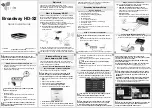
44
eNode:
Each Mojix eNode excites all passive RFID tags
within its designated interrogation space to a range of up
to 30 feet. eNodes can be fixed, wireless or handheld,
and can be deployed as needed to shape discrete,
overlapping or contiguous interrogation spaces, as well
as to create virtual fences for securing tagged items.
EPC:
Electronic product code.
EPCglobal:
A member-driven organization developing
global standards for EPC use.
eTag:
(see “eGroup.”)
Excision:
Removal or strong suppression of interfering
radio signals. The STAR uses excision, among other
tools, to operate reliably in very challenging and noisy
environments. (See “Interference.”)
Excite:
To transmit a radio signal with enough power and
the right communication to “wake up” a passive tag or
group of tags.
ENode:
(See “eNode”.)
FCC:
Federal Communications Commission (U.S.
regulatory body).
FileZilla:
A freeware file transfer protocol (FTP) Client
which allows SSH security.
Firmware:
Basic programming built into the STAR
receiver. Firmware consists of various sets of commands
the STAR is designed to understand and obey. Firmware
runs on the STAR’s microprocessor.
Frequency Band:
A range of frequencies on the EM
spectrum, typically defined by their applications or
authorized uses as designated by organizations such as
the FCC in the U.S. Frequency bands are often referred
to by their center frequencies. For example, the “915
MHz band” covers frequencies ranging from 902 MHz
to 928 MHz.
Frequency Hopping:
A method of transmitting RF energy
that minimizes interference among devices operating
in the same band. The reader frequency hops from one
specific point on the EM spectrum (within the frequency
band) to another and another (according to a “hopping
table” defined by the FCC and programmed into the
reader’s ROM) at precise 400 mS intervals.
IC:
Integrated circuit.
Integrated Circuit (IC):
Connected to a tag antenna, an
RFID IC is the brain of the RF tag. It rectifies (converts)
reader RF energy to power itself (in beam-powered and
hybrid beam/battery-powered tags), maintains tag memory
and has the intelligence to execute anti-collision functions
so a reader can read many tags in its field virtually at once.
Also referred to as “chip,” “die” or “device.”
Interference:
Any emissions in the electromagnetic
spectrum that have the capacity to disrupt, distort, weaken
or cancel the effective transmission of an EM signal. In
RFID, interference may come from other RFID devices
operating in the same frequency band, communication
devices operating in the same band, or spurious noise
emissions from mechanical sources that contain frequencies
in the RFID operating band. Interference is minimized
through the use of RF filtering and frequency hopping.
Interrogation Zone:
Fixed or mobile, STAR interrogation
spaces are business process-specific and can be optimized
for tag density or coverage. Each individually controlled
interrogation space is created by the deployment of single
or multiple eNodes and is dynamically sized by the STAR
system, which controls each node’s power output.
Interrogator:
(See “eNode.”)
Line of Sight:
Optical (barcode) systems of automatic
identification require that the laser scanner have an
unobstructed path (line-of-sight) to the barcode for reading
the UPC. Any objects between barcode and scanner will
prevent proper reading. Mojix STAR systems are not
limited to line-of-sight in that RF tags can be read through
or around most materials.
Master Controller:
The STAR Master Controller is a
dedicated Linux server, a Mojix software program called
Deployment Controller, and a mySQL relational database
that is used to store STAR System information and tag data.
Master Controller provides a single point in STAR for data
collection, communication with corporate business processes,
and command and control of the STAR System. When more
than one STAR 1000 receiver is deployed in a STAR System
due to the size or layout of the area of coverage, a single
Master Controller will control the entire system.
Multipath:
Multiple versions of the same signal (often
reflected by objects or materials in the RF operating
environment) that arrive at the reader at various times
(like an echo). Those that arrive in phase with the original
signal will enhance that signal. Those that arrive out of
phase will cancel the original signal.
Mux:
(“See eMux.”)





































